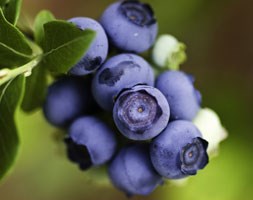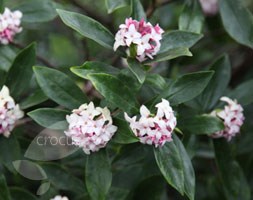Price reductions at Crocus
by Sarah - September 20th, 2013.Filed under: Crocus, Price Reductions.
Crocus has cut the price of these lines
Arum italicum (lords and ladies) was £5.99 now £3.99
Position: full sun to partial shade Soil: well-drained, humus-rich soil Rate of growth: average Flowering period: May to June Hardiness: fully hardy The lustrous, arrow-headed foliage, which is usually quite heavily patterned appears in winter, providing a colourful, groundcovering carpet during some of the bleakest months of the year. This tends to die back in late spring, but (in sunnier spots) it is followed by greenish cream spathes. Later still spikes of bright orange-red berries add further interest. An excellent plant for naturalising in a woodland setting – the leaves tend to be larger in partial shade. Garden care: Plant the tubers 10 deep and 15 – 20cm apart. Keep well watered during the growing season (winter and spring), but a dry summer and autumn dormancy is preferred.
blueberry ‘Ozarkblue’ (blueberry – late fruiting) was £12.99 now £9.99
Position: full sun or partial shade Soil: prefers moist, well-drained, acidic soil or ericaceous compost in a pot. Rate of growth: fast-growing Other features: light blue berries (July-August) Hardiness: fully hardy A late season, highbush cultivar with large, light blue berries with an exceptional flavour. It is the perfect cultivar if you want to extend your blueberry harvest by an extra month. The fruits are produced in abundance on an upright bush, and are preceeded by white, sometimes pink tinged flowers. It is fully hardy, but will still do really well in warmer areas. Garden care: Prepare the ground well before planting. Blueberries can also be grown in large pots and containers if ericaceous compost is used. Prune in winter, cutting out dead or damaged branches. In spring, feed with sulphate of ammonia, sulphate of potash and bonemeal and top-dress with ericaceous compost.
Daphne odora (daphne) was £14.99 now £12.99
Position: full sun or partial shade Soil: moderately fertile, well-drained, humus-rich soil Rate of growth: slow-growing Flowering period: January to March Hardiness: borderline hardy (may need winter protection) Lustrous, deep green leaves provide a handsome silhouette throughout the year, but it is for the small clusters of highly scented flowers that this rounded, evergreen shrub is most highly prized. Appearing in mid-winter, they open from purple-pink buds to reveal their pale pink petals, which usually have a richer pink reverse. Plant it somewhere that you pass-by regularly to make sure you can enjoy their delicious scent. Garden care: Keep pruning to a minimum since the plant is susceptible to die-back. Where necessary after flowering, lightly trim to remove misplaced branches and maintain a compact habit.









